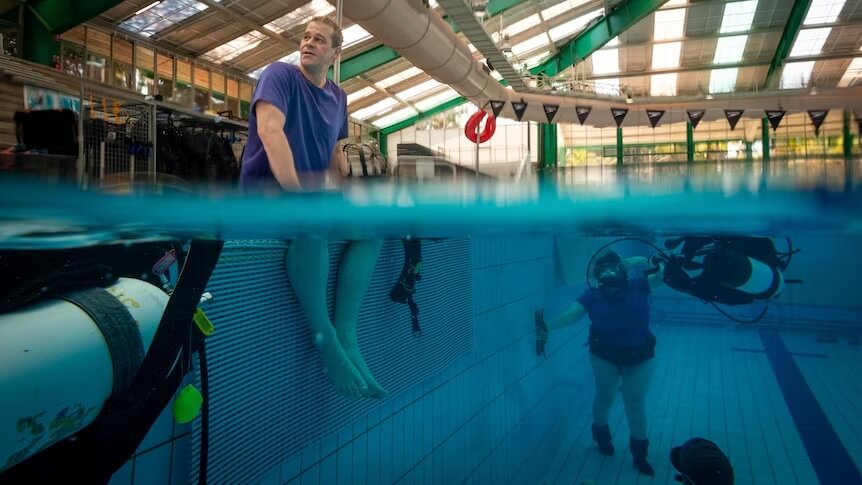Damian Jamieson said he tried every type of therapy to deal with the pain from an old back injury without success until he turned to the water — or more specifically, underwater.
Mr Jamieson started immersion therapy last year, donning a scuba suit to complete exercises underwater at an Adelaide pool twice a week.
He said one of the main benefits was removing the ‘fear factor'”‘ that often accompanied exercising after a serious injury.
“You tend to wrap yourself up in cotton wool and not take risks,” he said.
“If I fall over in the water, I’m not going to fall flat on my face, I’m not going to re-aggravate an injury, so that mental fear factor is immediately removed.”
In the 14 years since he injured his back in a work accident, Mr Jamieson has been through many treatments.
“I’ve had five surgeries on the back, multiple surgeries on the body, probably 40 in total,” he said.
“I’ve done hydrotherapy, physiotherapy, chiro, acupuncture … nothing’s really worked.
“There were times I just couldn’t see the light at the end of the tunnel.”
But he said immersion therapy had made a significant difference in his life.
“Today I’m a lot more motivated, [I have] a lot more energy, more confident,” he said.
“If I had an option like immersion therapy available to me earlier on in my rehabilitation phase, I would have been better off today.
“I probably would have had a better opportunity to be gainfully employed again.”
Two-year clinical trial to begin
A two-year randomised clinical trial at the University of South Australia will soon begin, aiming to look into the benefits of Determined2’s immersion therapy for people with brain and spinal injuries.
Lead researcher Dr Kade Davison has worked on two previous studies on immersion therapy that showed benefits but said those findings relied on anecdotal data.
“We’re testing whether or not the benefits we’re seeing anecdotally and qualitatively … translate to a measurable, objective outcome,” he said.
Dr Davison said the full immersion provides a “completely weightless environment” as opposed to traditional hydrotherapy.
“Being right down under the water means they can move as though they were moving in space outside of the water unobstructed, but completely with the effects of the buoyancy and all the other sensations and opportunities, challenges that the water provides,” he said.
Researcher and senior consultant in rehabilitation medicine Dr Maria Paul said she was sceptical about immersion therapy until she tried it for herself.
“It was really going out of my comfort zone as somebody who’s not a very good swimmer or who is quite afraid of water,” Dr Paul said.
“I found the whole experience was really comfortable.
“It gave me a lot of confidence to refer patients on to this mode of therapy.”
Peak physio body warns of safety concerns
However, Australian Physiotherapy Association Aquatic National Group chair Lilly Kochen said she held some safety concerns about the therapy.
“The immersion therapy, from what I have seen of it, does raise concerns in terms of safety and appropriateness for the kind of clients that are being offered this therapy,” she said.
Ms Kochen said the concept of immersion had been used for “many, many decades” in hydrotherapy, but the benefits can be there “without the head-under immersion”.
“The immersion of the body is what is of real value for these patients and for these people with these conditions,” she said.
Ms Kochen said careful screening was important to check whether the participant was suitable for the program.
Pete Wilson, the managing director of immersion therapy provider Determined2, said such screening was undertaken and safety measures had been incorporated into the program’s development.
“There is an exclusion criteria based on medical suitability,” Mr Wilson said.
“This assessment is done in line with the immersion therapy medical standards developed by leading experts in underwater medicine and rehabilitation medicine.
“To date over 10,000 sessions have been delivered without critical incident and the medical standards and assessment are a big part of that, ensuring people are safe.”
Would you consider this therapy for chronic pain? Is it being offered at a venue near you? Share your thoughts in the comments section below.
 © 2020 Australian Broadcasting Corporation. All rights reserved.
© 2020 Australian Broadcasting Corporation. All rights reserved.
ABC Content Disclaimer

